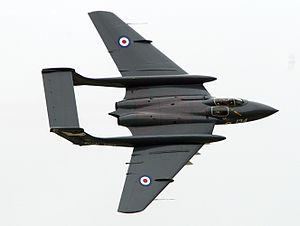De Havilland Sea Vixen
| DH.110 Sea Vixen | |
|---|---|
 |
|
| The only remaining airworthy Sea Vixen (civil registration G-CVIX) at the 2009 Yeovilton Air Show | |
| Role | Carrier-based fighter |
| National origin | United Kingdom |
| Manufacturer | de Havilland |
| First flight | 26 September 1951 |
| Introduction | July 1959 |
| Retired | 1972 |
| Primary user | Royal Navy |
| Number built | 145 |
The de Havilland DH.110 Sea Vixen is a twin boom, twin-engined 1950s–60s British two-seat jet fighter operated by the Fleet Air Arm. It was designed by de Havilland during the late 1940s at its facility in Hatfield, Hertfordshire. Developed from an earlier first generation jet fighter, the Sea Vixen was a carrier-based fleet defence fighter that served into the 1970s. Initially produced by de Havilland, it was later known as the Hawker Siddeley Sea Vixen after de Havilland became a part of the Hawker Siddeley group in 1960.
The Sea Vixen had the distinction of being the first British two-seat combat aircraft to achieve supersonic speed, albeit not in level flight. Operating from British aircraft carriers, it was used in combat in Tanganyika and in Yemen during the Aden Emergency. In 1972, the Sea Vixen was phased out in favour of the mach 2-capable McDonnell Douglas F-4 Phantom II interceptor. A single example remains airworthy today in the UK and is displayed regularly at airshows.
In 1946, the de Havilland Aircraft Company conducted discussions with the British Admiralty on its requirements for a future jet-powered all-weather fighter aircraft. From these talks, it became clear that the aircraft would need a crew of two to make effective use of radar and navigation equipment, that two engines were required for extra safety over the sea, and that a swept wing was desirable. It would also have a moderate wing loading for manoeuvrability at altitude and acceptable take-off and landing performance from carriers. Highly effective flaps would be needed for landing. De Havilland decided to pursue development of a design to meet the requirements of the Royal Navy. The proposed aircraft, which was designated as the DH 110 by de Havilland, was a twin-engined all-weather fighter.
...
Wikipedia
